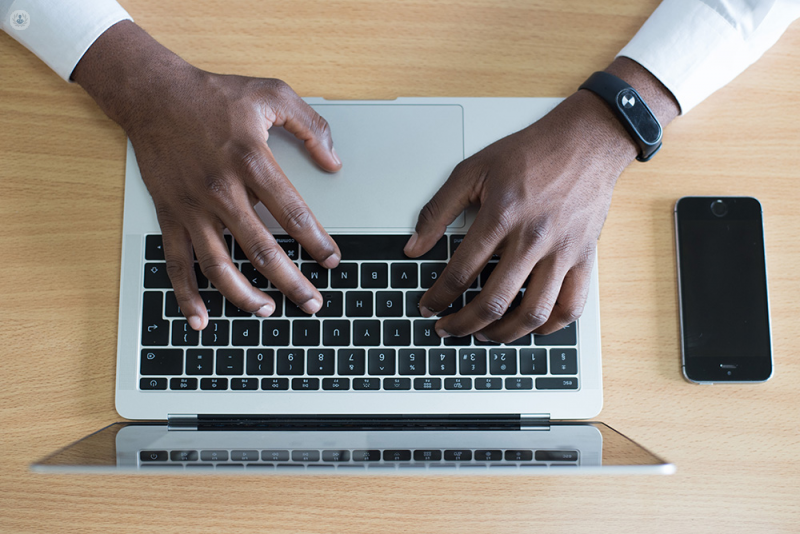Computer elbow can I get tennis elbow typing too much
Escrito por:Computer elbow, or mouse elbow, is essentially the same condition as tennis elbow in which the repetitive actions involved when working on a computer, such as the gripping and squeezing of a mouse and typing on a keyboard, causes muscle pain or tendon pain in your elbow.
We spoke to one of our top consultant orthopaedic surgeons, Mr Phil Wright, about this condition to understand precisely what causes it and what can be done to relieve the pain and prevent it returning.

What exactly is computer elbow?
Computer elbow, also known as tennis elbow and medically referred to as lateral epicondylitis, is a common cause of elbow pain. The risk factors for the development of tennis elbow have been extensively studied and it is generally agreed that in many people the onset can be related to certain activities. Whilst in some people it can be caused by strenuous movements over a short period of time, such as heavy lifting or cutting a garden hedge, it more commonly occurs with lower impact actions such as using a computer keyboard or mouse for several hours a day during the working week.
What causes computer elbow?
As with all painful tendon conditions, there are several theories, but the exact cause remains unknown. For many years, it has been widely believed that a minor injury to or repetitive movements of the elbow tendon causes a microscopic tear that fails to heal and the body’s attempts to repair are unsuccessful. The resulting scar in the tendon is weak, predisposing to further microscopic tears. As we get older, our bodies become less efficient in arranging and linking the proteins that make up the tendon which also makes them susceptible to injury.
What can I do to relieve the pain?
There are certain steps you can take to help relieve yourself of computer elbow or any other elbow pain caused by repetitive activity.
- Avoid or reduce the activity causing that caused the pain. This should be your first priority and you should also avoid or reduce any activities that cause the pain or make it worse.
- Try taking over-the-counter anti-inflammatory medication. A short course of anti-inflammatory tablets available from supermarkets and pharmacies such as ibuprofen often help the pain.
- Keep the elbow moving to avoid stiffness. Stretching exercises can be useful: hold the arm straight, with the palm facing to the floor and slowly bend the wrist downwards using the other hand to gently pull it towards the body and hold for fifteen seconds. This can be repeated four to six times a day.
- Massaging the painful area can often give significant relief. Start just above the painful area on the outside of the elbow, and using the index and middle fingers of the opposite hand, with firm pressure rub in a side to side motion working over the painful area gradually moving towards the hand. This can be repeated four to six times a day.
- Try wearing an elbow clasp or brace helpful. Some patients find this helpful. These are available from pharmacies or via the internet and cost between £10 and £20. They apply gentle pressure to the muscles just below the tendon and may reduce the strain on the tennis elbow area during repetitive or strenuous movements.
What do I need to change?
Where elbow pain has arisen as a result of work or leisure pursuits, it is important to try to identify factors that may be modified so you can return to these activities as soon as possible.
Ways to adapt your workspace
When working at a computer on a desk there are adaptations to using a keyboard or mouse that can prevent the prolonged stress on the elbow tendons that can cause pain. A “vertical mouse” used with the hand resting on its side rather than facing the floor avoids placing the wrist and forearm in a position where the tendons are under tension. This is best used with a narrow keyboard (without number keys on the right) as this allows the mouse to be used with the arm resting at the side rather than held away from the body by the shoulder.
Other ergonomic changes can often be fruitful, such as using a chair with lumbar support and adjustable height to ensure that the computer screen is level with the eyes. Whenever working for prolonged periods at a computer it is important to take regular breaks to allow a change in posture and ease any strain on the neck, shoulders and lower back.
What happens if the pain in my elbow doesn't improve?
Whilst tennis/computer elbow is a painful condition that can interfere with many aspects of daily life, it is widely accepted to be self-limiting, that is it doesn’t progressively deteriorate to the extent that it becomes disabling. For most people, it lasts around six months and on the assumption that symptoms can be self-managed with simple measures, this is the best course of action to take whilst the problem naturally resolves. The pain eventually settles and life returns to normal without any lasting effects. It is rare for tennis/computer elbow to return in the same arm once it has resolved.
If symptoms are severe and fail to improve after six weeks, it is worthwhile seeking the advice of a doctor or physiotherapist. They will ask questions and examine the elbow to exclude other potential causes of elbow pain. In some cases, an X-ray or scan can help confirm the diagnosis, although in most cases this is unnecessary. A physiotherapist can give advice on exercises and other forms of self-management. They can also arrange a referral to a specialist if required.
Can steroid injections help?
Traditionally one of the most common treatments for computer/tennis elbow was an injection of steroid into the painful area. Recent scientific studies have suggested that whilst steroid injections can relieve pain for around six weeks, they increase the chances that the problem will persist for twelve months or more. Most elbow specialists now advise against the use of steroid injections for this problem.
A new alternative to steroid injections or surgery is the injection of “platelet-rich plasma”. This involves taking a blood sample from a patient and placing it in a machine (centrifuge) that spins the blood and allows growth factors from the patient’s own blood to be extracted. These growth factors are re-injected around the painful tendons to stimulate a healing response. Whilst outcomes are not guaranteed, this procedure avoids the potential complications of surgery and might be just as effective.
When is surgery needed?
Surgery is often suggested as a treatment for painful tendons. Around the elbow, this can be done through a small incision or keyholes which are known as arthroscopic surgery. The results of both types of surgery are very similar. It is important to be aware that surgery has not been proven to be more effective than any other treatment for tennis elbow and outcomes are never guaranteed.
Should I take time off work?
Whilst it is often difficult to work with computer/tennis elbow it is wise to avoid taking time off if possible. The aim is to be able to manage elbow pain and remain in employment whilst the condition naturally resolves. Often the support of the employer will be required to achieve this. It may involve the provision of specialised equipment, such as a vertical mouse and/or compact keyboard. Larger employers have access to specialists who undertake a workplace assessment and advise on ergonomic adaptations to reduce the impact of elbow pain.
Patients in heavy manual work may benefit from adaptations to tools and machinery or in some cases, can be helped by being given light duties while they recover.
When should I see a doctor?
Although computer elbow is a benign and self-limiting condition, there are other disorders that can cause elbow pain and may benefit from early assessment by a doctor. If there has been a significant injury to the elbow that had caused bruising or swelling, an examination by a doctor is required to ensure there has been no damage to bones, tendons or ligaments.
If there is redness or swelling associated with severe pain and stiffness then arthritis (loss of cartilage) is a possible cause and a doctor should be consulted with a view to an X-ray. If there is swelling, redness and severe pain with any attempt at movement, infection of the elbow joint is a rare but very serious possibility and requires urgent medical assessment.
If you are suffering from elbow pain and would like to see a specialist, visit Mr Phil Wright’s Top Doctors profile and check his availability.


